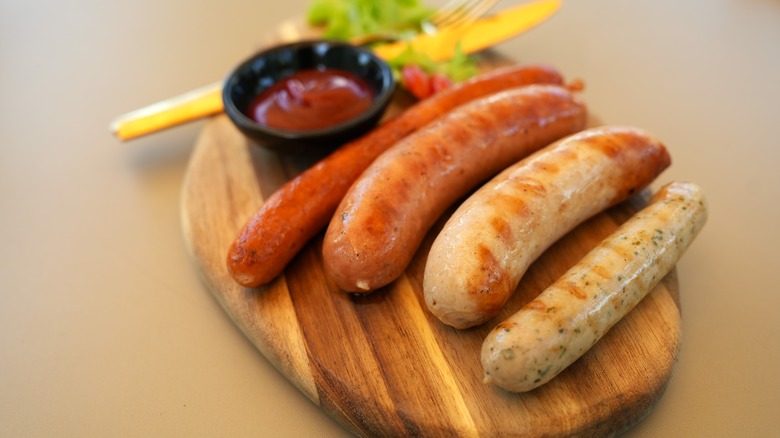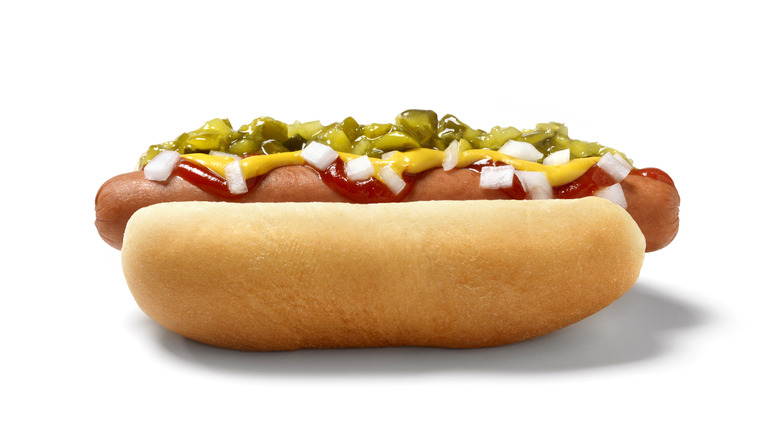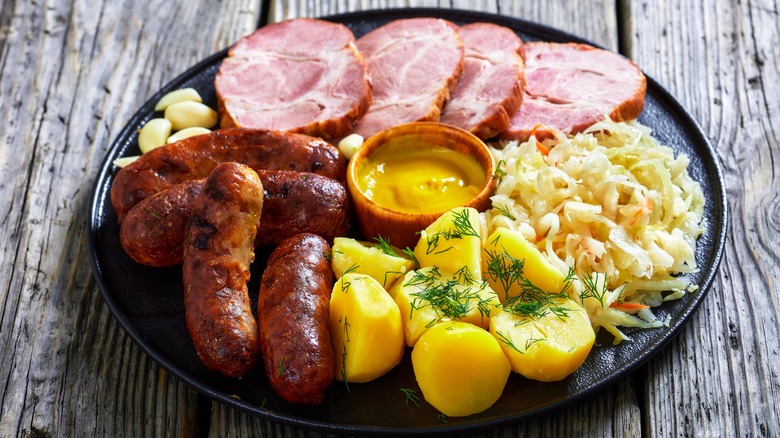Brats Vs Hot Dogs: The Difference Between These 2 Cookout Classics
There is something about summertime that makes many people crave hot sausages off the grill, covered in condiments and stuffed into buns. In other words, bratwursts and hot dogs are classic summer fare. Despite the two both having German origins and consisting of meat stuffed into casings, brats and dogs have some substantial differences. The obvious contrast is their size and shape, with hot dogs typically being much longer and skinnier than the shorter, fatter bratwursts. But the two are also made with different ingredients, don't share many flavoring spices, and have very different textures.
Because of the prominent meaty, salty, and umami flavors of both hot dogs and bratwursts, they taste great with similar toppings, like mustard, sauerkraut, onions, and sweet roasted peppers. But their differences are worth celebrating as well, because the two can be flavored very differently. While different brands of hot dogs will still taste relatively similar, bratwursts can be flavored with all sorts of unexpected spices.
Not all sausages are made the same
Technically, both hot dogs and bratwursts are sausages, or ground meat that is flavored and forced into thin casings. But the meats that each are made with are rarely the same. Hot dogs can be made from a mixture of pork, beef, chicken, and turkey, while bratwursts are mainly made from pork, and sometimes contain beef or veal. The meat mixture in hot dogs is so finely ground that it becomes paste-like, or completely emulsified before it's put into casings. In addition, hot dogs are pre-cooked, so they can technically be eaten right from the package, although they tend to taste much better when heated.
To make bratwursts, pork is also processed, but the meat is coarser, giving the sausage much more texture than a hot dog. Whereas hot dogs are mainly spiced with salt, garlic, and paprika for some color, bratwursts can be flavored with practically the whole spice cabinet; things like lemon zest, caraway seed, nutmeg, ginger, and more can be added. Because of this, bratwursts have a much wider range of flavor. Sometimes, the addition of an ingredient can change the wurst completely. For example, if pig blood is added, it becomes a blutwurst, or blood sausage. You can occasionally find hot dogs that contain cheese, or ones that are made from all beef or all pork, but in the end, they are all still hot dogs.
To bun or not to bun?
For the most part, hot dogs are eaten in buns and topped with a huge array of ingredients (or sometimes none at all). Depending on where you are in the country, and the world, a hot dog can have multiple personalities. In Chicago, the traditional dog comes in a poppy seed bun and is practically topped with a garden. Swedish hot dogs, called tunnbrödsrulle, contain a wiener that is wrapped in flatbread and accompanied by mashed potatoes and shrimp salad. But all in all, hot dogs come in some sort of bread roll.
Bratwursts, too, are widely eaten in rolls in the United States, but according to a Reddit post, Germans often enjoy the sausages without the bun. Germans also put their brats in buns too, often when they are eating on-the-go. Once cooked in a pan or grill, it can be served as the main meat on a plate with potato salad or mashed potatoes and vegetables, and you'd eat it with a knife and fork. Multiple contributors agreed that mustard is always a suitable condiment, but so is ketchup. Meanwhile, in America, ketchup on a hot dog is considered a huge no-no for many. Interestingly enough, cheese shouldn't ever be on a wurst in Germany, according to some comments in the post.


